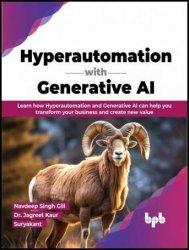 Название: Hyperautomation with Generative AI: Learn how Hyperautomation and Generative AI can help you transform your business and create new value
Название: Hyperautomation with Generative AI: Learn how Hyperautomation and Generative AI can help you transform your business and create new valueАвтор: Jagreet Kaur
Издательство: BPB Publications
Год: 2024
Страниц: 812
Язык: английский
Формат: pdf, epub
Размер: 10.2 MB
Understand how to leverage Hyperautomation and Generative AI to accelerate Business Transformation.
Key Features:
- Explores a wide range of use cases and examples that demonstrate the diverse applications of Hyperautomation across industries, sectors, and specific departments.
- Familiarizes you with popular tools and platforms like UiPath, Automation Anywhere, and IBM.
- Discovers how existing organizations utilizing AI and RPA technologies can leverage Hyper automation to rapidly expand automation initiatives across various business verticals.
- Rise of Generative AI and its Tectonic Shift in industries and technologies.
Description:
Hyperautomation and Generative AI, when combined, can create powerful new capabilities for businesses. If you are a business leader looking to improve your productivity, efficiency, and customer satisfaction by adopting hyperautomation and generative AI technologies, then this book is for you.
This book provides an introduction to hyperautomation, highlighting its key components and providing guidance on how organizations can implement it to streamline everyday business operations. The book covers a comprehensive range of use cases and examples that demonstrate the diverse applications of hyperautomation across industries, sectors, and specific departments within companies. It also familiarizes you with popular tools and platforms like UiPath, Automation Anywhere, and IBM, enabling them to make informed decisions when selecting the appropriate technology for their digital transformation endeavors. Lastly, the book illustrates how existing organizations that are already utilizing AI and RPA technologies can leverage hyperautomation to rapidly expand their automation initiatives throughout various business verticals.
The history of Generative AI goes back to the 1950s and 60s, when researchers first started exploring the potential of AI. This time, they focused on creating a system of control that could influence people’s thoughts and decisions. Over the years, researchers have begun experimenting with emerging models in fields as diverse as speech recognition, image processing, and natural language processing. As the millennium approaches, models such as Bayesian networks and Markov models are finding application in robotics and computer systems. But the real breakthrough comes from the teaching and development of deep learning. This increases the ability to develop skills. In 2014, the release of Generative Adversarial Networks a machine learning algorithm, enabled manufacturers’ artificial intelligence applications to generate realistic images, video and audio of real people.
Generative AI has gained significant attention with the rise of Deep Learning models. Generative AI is a form of Artificial Intelligence technology that can produce various types of content, such as text, images, audio, and synthetic data. It has gained attention recently due to its ability to generate high-quality content quickly. Variational Autoencoders were among the first Deep Learning models used for generating realistic images and speech. VAEs enabled the scaling of generative models and paved the way for subsequent technologies like GANs and diffusion models.
Generative AI models, including VAEs and transformers, are built on the architecture of encoders and decoders. Transformers, introduced in 2017, revolutionized language models by combining the encoder-decoder architecture with attention mechanisms. Transformers can be pre-trained on vast amounts of raw text, allowing for efficient learning of powerful language representations. These models can later be fine-tuned for specific tasks with smaller amounts of labeled data. Transformers, also known as foundation models, have brought versatility to the field of natural language processing. They have applications in classification, entity extraction, translation, summarization, question answering, and even generating convincing dialogue and content. Language transformers can be categorized as encoder-only models (for example, BERT), decoder-only models (such as, GPT), or encoder-decoder models (for example, T5).
By the end of the book, you will have a deep understanding of the potential of hyperautomation and generative AI to transform businesses.
What you will learn:
- Understand the importance of developing the necessary talent, skillset, and IT infrastructure for successful Hyperautomation implementation.
- Explore different strategies for scaling automation initiatives across different business verticals.
- Understand how to solve diverse business problems using Hyperautomation through a high-level plan.
- Understanding the essential technologies like AI, machine learning, and deep learning and their contributions to Hyperautomation.
- Understand the benefits of using Hyperautomation with Generative AI.
Who this book is for:
This book is for professionals who are interested in automation and Generative AI. It covers the development and execution of diverse business processes, and is relevant to a wide range of roles, including digital transformation consultants, CxOs, technical architects, AI engineers, enterprise architects, RPA engineers, and automation engineers.
Скачать Hyperautomation with Generative AI: Learn how Hyperautomation and Generative AI can help you transform your business